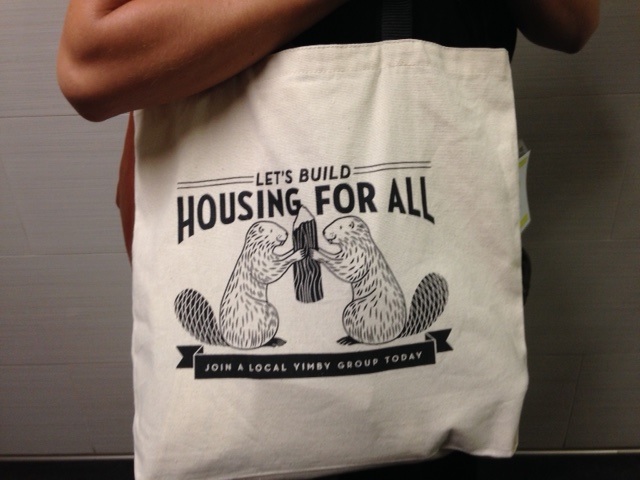On December 8, East Bay Yimby, a chapter of Yimby Action, sent the Berkeley City Council a petition with 31 signatures asking that the council “support evidence-based selection of sites in Berkeley’s Housing Element.” The two-page document encapsulates the Catch-22 at the heart of Yimby doctrine: blame cities for the market-driven housing crisis, then perpetuate the crisis by enshrining the market imperative in law and public policy. The petition also hints at Yimbyism’s hegemony at the University of California.

To grasp the Yimby catch-22, you need to know the basics of California’s super-wonky housing element law. For a lucid deep dive, see Michael Barnes’ recent piece in Berkeleyside. What follows is a primer.
State and regional planning authorities require each local jurisdiction to zone for a specified number of homes that accommodate households at every income level. The number is called the Regional Housing Need Allocation or RHNA (sounds like ree-nuh). The RHNAs for each region are re-calculated every eight years.
After the passage of Scott Wiener’s SB 35 in 2017, the state also mandated that if developers don’t pull building permits commensurate with a city’s RHNA, the city loses its discretion over housing and has to grant “by-right” or ministerial approvals of housing projects. That means no public hearing and public process.
The Yimby assumption—Wiener is California’s arch-Yimby—is that what keeps developers from building housing are onerous local regulations—above all, low-density zoning. Allow higher density (upzone), and developers will build, build, build.
That assumption is questionable. As Michael Barnes observes, developers’ primary goal is to make money, not to build housing. If the market is unfavorable, they will not build, even if they have a building permit for a project. They will flip their entitlement to another developer or wait until the market turns. Moreover, developers are loathe to build housing affordable to the neediest households, because it doesn’t yield the profits that demanded by their investors. Predicated on a fundamental misunderstanding or misrepresentation of developer motive, SB 35 sets up cities to fail.
In 2018, the setup got a lot worse, thanks to another Wiener brainchild, SB 828. SB 828 changed the basis for calculating the RHNAs, resulting in exponentially larger housing allocations. Berkeley’s target for the upcoming, sixth RHNA cycle is 8,937 housing units—a 300 percent increase over the city’s fifth cycle target of 2,959 and, as Barnes notes, a 17 percent increase over the number of existing homes in the city.
SB 828 also extended the capitalist profit imperative further into California’s housing policy, stipulating that every city make
[a]n inventory of land suitable and available for residential development, including vacant sites and sites having realistic and demonstrated potential for redevelopment during the planning period to meet the locality’s housing need for a designated income level, and an analysis of the relationship of zoning and public facilities and services to these sites. [Government Code 65583 (a)(3)] (emphasis added)
Cities now have to do a “capacity analysis”—meaning capacity for housing development—of every site they want to count toward satisfying their allocations. Added to SB 35, SB 828 puts cities in double jeopardy from market-driven decisions about housing construction.
To Yimbys, this is catnip. Echoing SB 828, the East Bay Yimby petition urges the Berkeley council to “direct planning staff to only include housing element sites that are realistic [sic] and likely to be developed, or [to] discount the capacity appropriately.”
The state allows cities to count nonvacant sites toward meeting their housing allocation. But as the petition notes, California law now “requires ‘substantial evidence’ that the current use on a nonvacant site will be discontinued for it to count as a low-income site.” Borrowing an example from the state guidelines, East Bay Yimby writes: “This means reaching out to the landowner and confirming that they intend to redevelop [the site]. If it is a big-box store or successful business with no plans to redevelop its capacity should be discounted accordingly.”
As the petition also notes, another factor that the state “recommends”—actually requires—cities to consider when doing a capacity analysis is “development trends of housing element sites in the previous RHNA cycle.” To illustrate what that involves, East Bay Yimby offers the following scenario:
Just as a university sends out many more acceptance letters than the number of seats they would like to fill in a freshman class, cities need to designate more sites in their site inventory than the RHNA target[,] to account for the fact that not every site will be redeveloped in the next eight years.
In other words, applicants with letters of acceptance in hand who have yet to enroll are like developer-ready sites. Just as prospective enrollees have the whip hand over the university, prospective developers have the whip hand over the cities.
The petition states that “[i]n the last RHNA cycle, one study found that only 9% of sites in the typical Bay Area City were actually developed; it was even lower for Berkeley, only about 2.5%.” Proceeding on the dubious assumption that a major factor in the housing crisis is zoning-constrained supply, the signatories see those percentages as “suggest[ing] that Berkeley may need to zone for 10 times its RHNA target to actually meet its RHNA.” The petition notes that Berkeley’s RHNA for the upcoming eight years is 9,025 units. It does not note that according to the U.S. Census, the city’s population as of 2019 was 121,363. The idea, then, is that Berkeley plan for 90,250 new housing units, or separate homes for 74 percent of its current residents, albeit assuming that only a fraction of those units would actually get built.
This is real estate speculation tricked out as city planning. The parody is ludicrous, but it’s hard to laugh, because the proposal to increase RHNA zoning by an order of ten and the university scenario come from a study published by UCLA’s Lewis Center for Regional Policy Studies. The four co-authors include two of the petition’s signatories, Sidharth Kapur and Salim Damerdji. The other two authors are UC Davis Professor of Law Chris Elmendorf and UCLA Associate Professor of Urban Planning and Public Policy Paavo Monkkonen.
In Spring 2021, Monkkonen co-taught a graduate level class, “Current Issues in Urban Planning: Reviewing Housing Elements in Southern California,” that assigned students to review the housing elements of one or two SoCal cities. Monkkonen’s fellow instructors were Jes McBride and Jon Wizard, described in the class syllabus as “leads in the Campaign for Fair Housing Elements of Yimby Law.” The syllabus was posted on the Yimby Law website earlier this year but appears to have been removed. McBride signed the East Bay Yimby petition to the Berkeley council, as did Damerdji and Yimby Law Executive Director Sonja Trauss.
Oddly, a Zip Code appears beside the name of each signatory to the petition. The Zip Code associated with Trauss is 94607, which indicates a West Oakland residence. McBride and Damerdji both list 90042, which is in LA. That’s notable, given that the petition begins: “As a resident of the Bay Area….” Other signatories include people with Zip Codes from Santa Monica, Pasadena, Davis, Los Angeles, Santa Cruz, Laguna Woods, and Auburn. A sign of the notorious Yimby cosmopolitanism?




